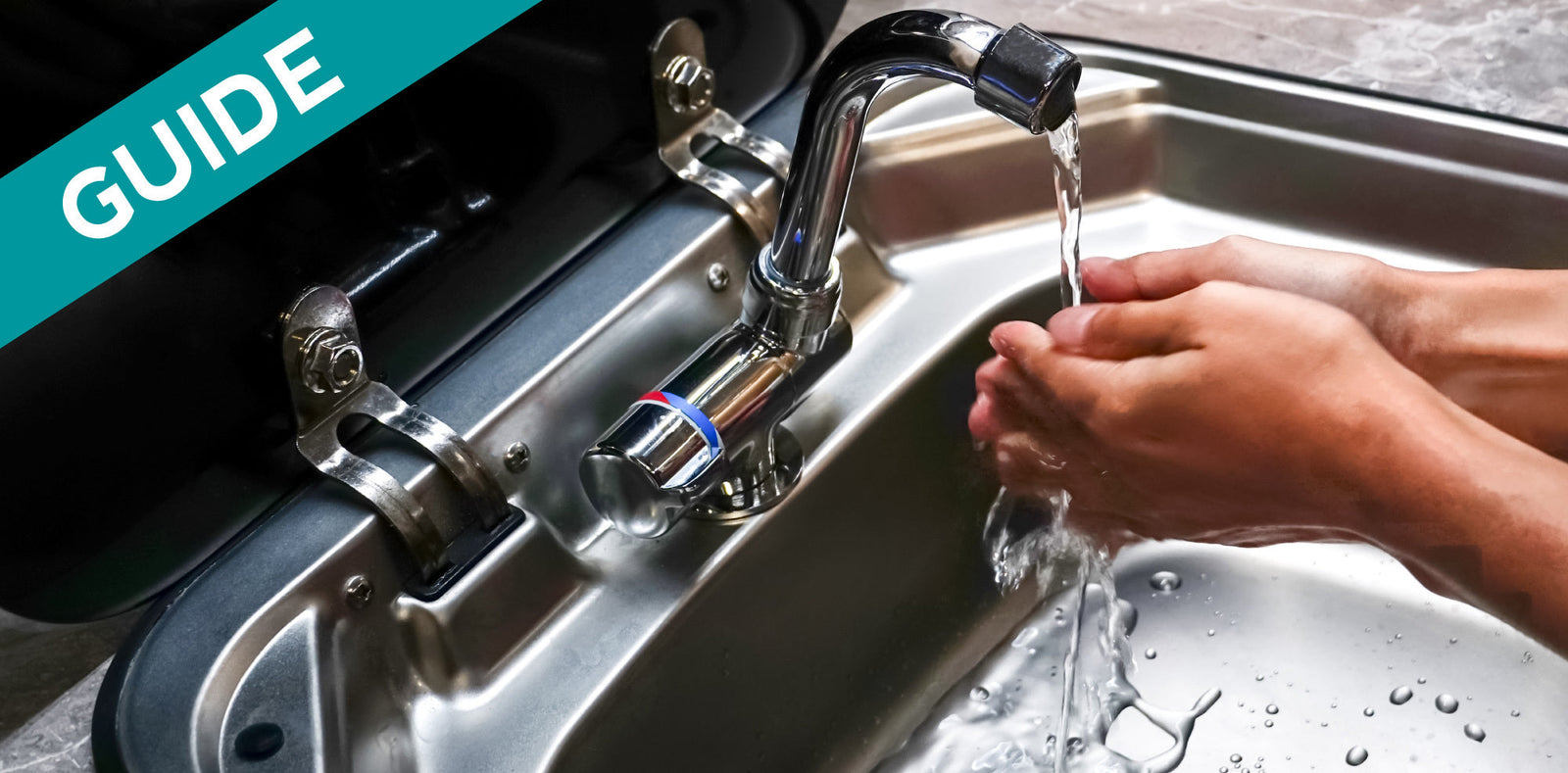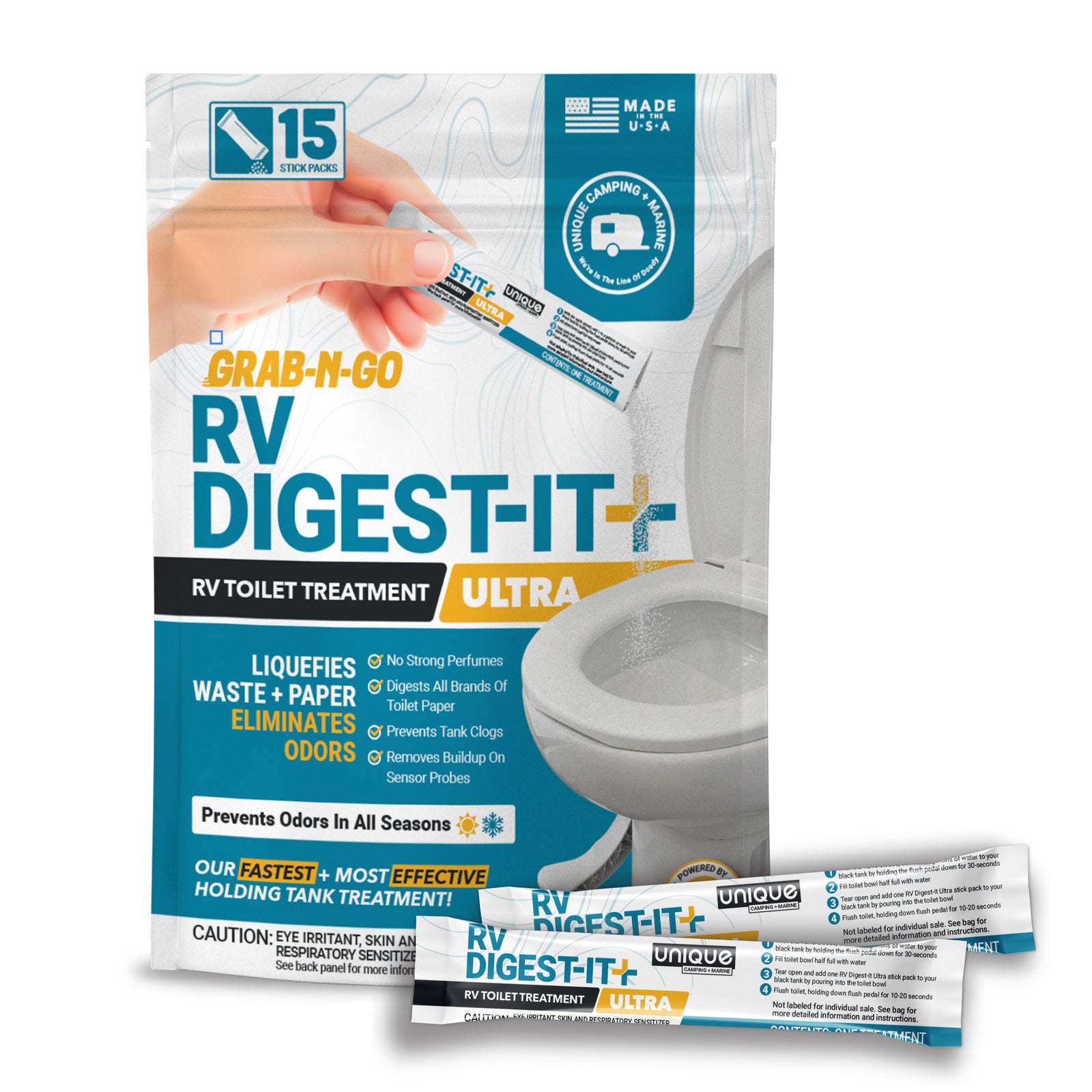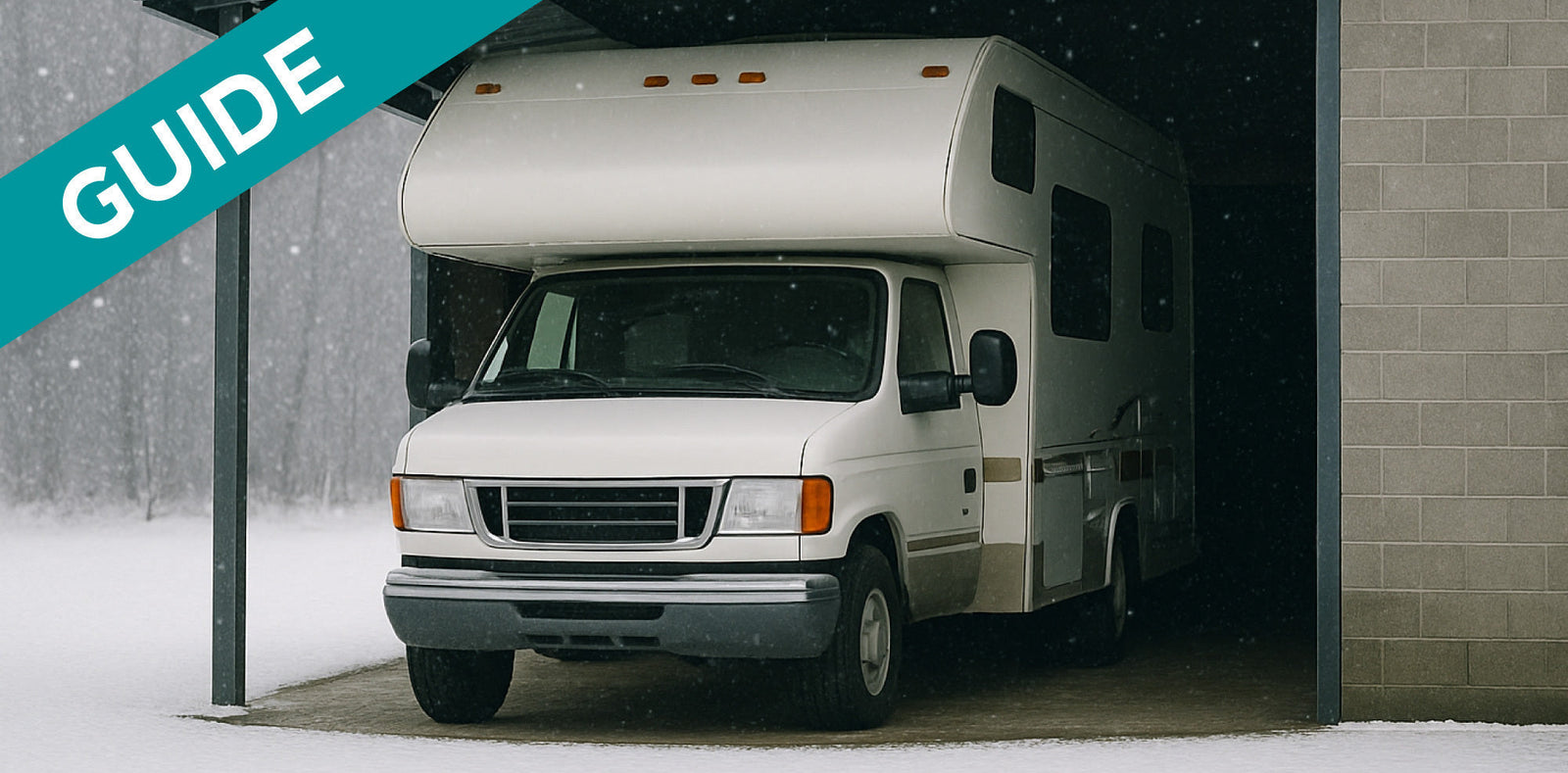
RVers often ask us about the best way to deep clean RV grey water holding tanks. Some RVers may already be dealing with problems they are trying to solve, while others simply want to avoid having tank issues altogether. Deep cleaning your RV gray water tanks is a simple process, meaning that you can get started with minimal time and supplies for fast results.
For instructions and advice about deep cleaning RV black water tanks, please review our guide about How to Deep Clean RV Black Water Holding Tanks.
Key Points About Cleaning RV Gray Water Tanks
- Gray water tanks may need to be cleaned frequently depending on the type of camping you’re doing.
- Deep cleaning gray water tanks is easy, inexpensive, and can be taken care of while you sleep.
- Hookup campers and dry campers need to approach deep cleaning with slightly different methods.
- Common homemade treatments and techniques that are shared online rarely provide you with the best results.
Why is Deep Cleaning RV Gray Water Tanks Important?
While black water holding tanks are a well-known source of unpleasant odors inside of an RV, it is important to consider the smells that can rise from your RV’s kitchen sink and shower drains. As things like soap scum, food grease, lotions, or human hair build up, your gray or galley tank(s) can quickly become the source of unwanted odors.
Additionally, as you use your gray water tank, grease and oil can build up and cover tank sensors, causing them to misread. No RVer wants to guess if their gray water tank is full or not, and so keeping sensors free from residue will help them continue to function properly.
Fortunately, because your gray tank does not usually contain solids, deep cleaning your gray tank is very easy — all you have to do is remove the grease that has built up inside of the tank. This process is like a complete reset for the gray tank and helps restore it to its original condition. Don’t stress if you find yourself needing to deep clean your gray tanks relatively often, grease and build-up can accumulate from regular use even if you are following a strong maintenance routine - and this process is quick, inexpensive, and simple!
Note: To prevent solid waste from getting into your gray/galley tank(s), we recommend that you use a sink or drain strainer to catch residual food waste and other debris. Ideally, you should also remove grease and food scraps from dishes before washing whenever possible.
For hookup campers, remember we recommend leaving your gray tank valve open to prevent odors and misreading sensors. We know some of you may be concerned with this advice, but know that we have your best interests in mind. We’ve been recommending this for decades now, and we’ve never had a time where it backfired.
Best Way to Deep-Clean RV Gray Water Tanks
Deep cleaning RV gray water tanks is very easy, which should make sticking to a regular cleaning schedule relatively painless.
Supplies you need to deep clean your gray water tank:
- Water
- Grease-eating dish soap (Dawn Ultra)
- Time
Through years of experience with customers, we’ve found that the best product out there for removing gray tank grease and residue is Dawn Ultra dish soap. It may seem counterintuitive to add more soap to a gray tank that is already coated in soap scum and grease, but it is an incredible grease-eater that doesn’t leave a layer of residue like other soaps. You can still use other dish soaps if you don’t have Dawn on hand, but we’ve found most of them ineffective, so stick to Dawn Ultra when possible.
Similar to when cleaning RV black tanks, you can let the cleaning product — the Dawn Ultra in this case — do all of the work while you sleep.
Steps for deep cleaning an RV gray water tank:
- Close your gray tank valve.
-
Fill your gray tank completely with fresh water.
Note that it is crucial to fill the tank as much as possible because cleaning only occurs where water is touching. If you are attempting to restore your gray tank sensors, be sure that water covers the highest sensor in your gray tank.
-
Pour at least 20 ounces of Dawn Ultra dish soap down your RV’s kitchen sink.
There is no amount of Dawn Ultra that is too much. You may see the soap foaming back out of your sink or shower lines — an indication you’ve poured enough Dawn into the tank —- which is a good sign. This lets you know that the grease-eating dish soap is actively spreading throughout your RV’s pipes and cleaning out all the built-up residue.
- Allow Dawn Ultra to sit in the tank and lines overnight.
-
Open your gray tank valve and empty your gray tank.
When emptying your tank, it is very common to see grayish-white residue on the bottom of your holding tank discharge pipe. This is the grease that was previously clinging to the inside walls of your holding tank.
-
Rinse your gray tank thoroughly.
Fill your entire gray tank with fresh, clean water, then dump the tank to completely rinse your gray tank.
-
Repeat these steps if necessary.
Unlike deep cleaning your black tank where time is magic, there is no benefit to leaving Dawn Ultra in your gray tank for long periods of time. The magic of Dawn is repeat cleaning, so you may need to repeat this process a few times to achieve the desired results if your tank is especially dirty. Sometimes it can take several deep cleanings before the gray tank is spotless inside.
Routine deep cleaning of both your gray and black tanks will help prevent issues, and keep your RV wastewater systems running smoothly.
If you need guidance about deep cleaning your RV black water tank, please refer to our guide: How to Deep Clean RV Black Water Holding Tanks.
If you need help restoring your misreading tank sensors, look no further than our guide about How to Clean and Restore RV Wastewater Sensors.
RV Gray Water Cleaning: Hookup Campers vs. Dry Campers
Similar to black water RV tanks, it’s a good idea to deep clean your gray tanks on a regular schedule based on the kind of camping you’re typically doing.
Hookup Campers
If you are primarily a hookup camper, we recommend deep cleaning your gray tank twice a year, once at the beginning of the RV season and once at the end. We recommend this schedule as long as you are leaving your gray tank valve open. By leaving your gray tank valve open, rather than letting water accumulate and allowing grease and residue to build up on your tank walls, water can continuously trickle out without issue. This helps prevent sensor issues and foul odors.
If you follow our advice about gray water valves, when leaving your gray tank valve open, we recommend making a p-trap in the hose running to the sewer. This will create a water barrier to prevent sewer gasses from backing up into your RV. Please note that in some states, your waste hose cannot touch the ground, so please make sure you follow all local laws and ordinances.
Dry Campers
If you are primarily a dry camper, or boondocker, we recommend deep cleaning your gray tank on the last night of every camping trip to avoid grease buildup inside your gray tank. We recommend this schedule knowing that you must keep your gray tank valve closed when you dry camp.
You must keep your gray valve closed when dry camping because dumping large amounts of used water is prohibited on public lands. For more information about proper tank dumping, please refer to our article about Where to Dump Your RV Holding Tanks.
Deep Cleaning RV Black/Gray Water Combo Tanks
Determining the right way to deep clean RV combo tanks can be confusing because you may be uncertain about what to do when using them as both a gray and black water tank.
Here are a few tips about how to clean your combo tank based on your usage:
- Using a combo tank as only a gray water tank,refer to the steps in the Best Way to Deep-Clean RV Gray Water Tanks section above.
- Using a combo tank as only a black water tank,refer to our guide about How to Deep Clean RV Black Water Holding Tanks.
- Using a combo tank for gray and black water,start by cleaning it as if it were solely used as a black water tank. If you think there may be excessive amounts of grease or soap scum that were not removed with the black tank cleaning method, then follow the gray water tank cleaning steps as well.
Cleaning combo tanks can be straightforward as long as you make sure to clean them based on your usage. If you’re ever unsure, start by using the black water tank cleaning method and then follow with the gray water tank cleaning method afterwards. Utilizing both deep cleaning procedures is completely fine, and can only help clean your combo tank more thoroughly.
Cleaning Advice from the RVing Community
The RVing community is great about sharing tips, best practices, and other advice about how to get the most out of your RV and RVing experiences. However, in terms of proper maintenance and deep cleaning of RV gray and black water tanks, the advice can sometimes be less than helpful, or even completely inaccurate.
Before taking deep cleaning advice from other RVers, we suggest that you read our article outlining Common RV Holding Tank Myths Debunked. This information will save you wasted time and effort on deep cleaning methods that simply don’t get the job done.
For proven and tested RV deep cleaning guidance, The Unique Method is the only thing you need to solve 99% of your RV wastewater problems. Created over 30 years of professional wastewater problem solving, The Unique Method ensures that you will have properly functioning holding tanks for years to come. There are no gimmicks involved, all you need to do is follow the clear set of rules and use the right products. It’s that simple!
RV Gray Water Tank Cleaning: Summary
Deep cleaning your RV gray water tank will allow you to enjoy every camping trip worry-free. By maintaining a regular cleaning schedule based on the type of camping you’re doing, you can avoid being plagued by unpleasant odors and sensor misreads, and have confidence that your wastewater systems will function properly long term. Remember that no amount of grease-eating Dawn Ultra is too much, and repeated cleaning cycles are the best medicine when it comes to deep cleaning gray water RV holding tanks.
If you are looking for additional information and guidance about deep cleaning RV black water tanks, take a look at our guide explaining How to Deep Clean RV Black Water Holding Tanks.

Prevent Common Problems In Your Tanks!
From misreading sensors, preventing clogs, or eliminating odors, we've got you covered no matter how you camp! All our best holding tank tips and trick information plus more can be found conveniently in one place when you download our FREE Unique Method Field Guide PDF. Achieve holding tank bliss today!
Get The Free Download Get The Free Download



